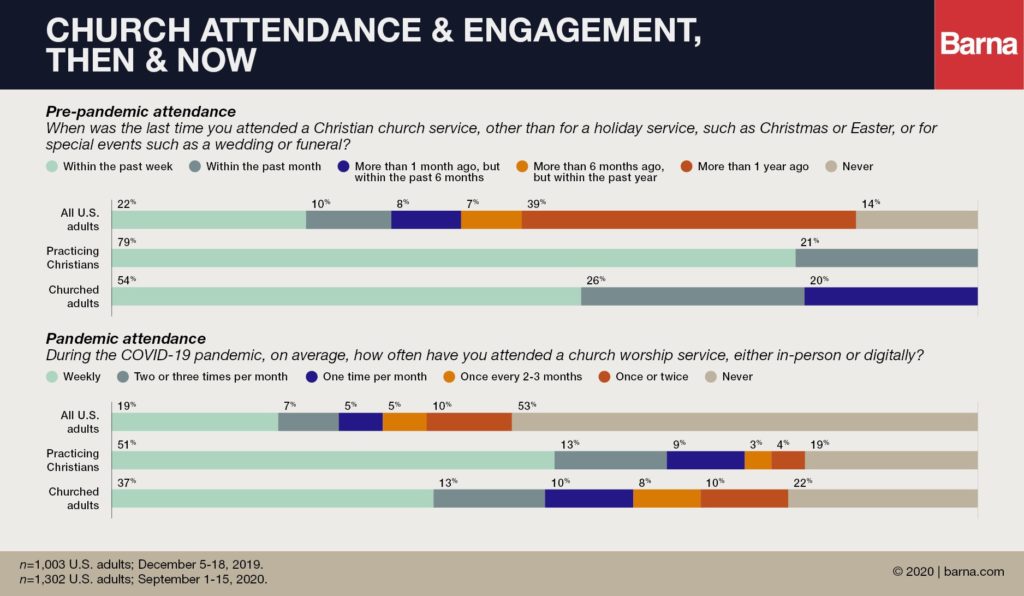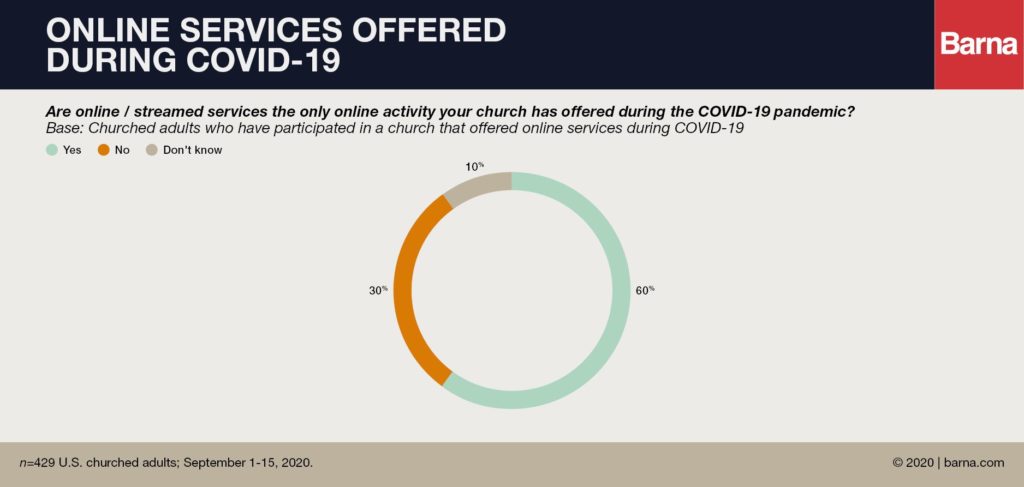
An excerpt from Barna’s new report, Six Questions About the Future of the Hybrid Church Experience
In the spring of 2020, as much of the United States began enforcing social distancing measures to prevent the spread of COVID-19, the overwhelming majority of churches accordingly closed their doors. Ministries shifted quickly to digital services as faith leaders and congregants encouraged each other with the reminder “Church is more than a building.”
But can digital ministry become more than a sermon? Our data collected during the 2020 tumult — releasing in a new report, Six Questions About the Future of the Hybrid Church Experience — suggest that a more holistic strategy for digital or hybrid ministry is needed for the long term. With overly optimistic or unclear ideas of how churchgoers are engaged in online services—typically the only digital option churches provide—pandemic-era pastoring may be largely devoid of meaningful touchpoints with congregants. This grey area surrounding online attendance is an urgent challenge of digital and hybrid ministry and underscores the need for more than streamed services.
One in five churchgoers has never attended church online during COVID
Barna has tracked a gradual movement away from regular church attendance over the years, particularly among younger adult generations in the U.S. But during COVID-19, a more obvious and abrupt decline occurred—even among groups who are typically faithful. Here, we’ll look at churched adults, who typically attend church at least once in six months, and practicing Christians, a subset of churched adults made up of Christians who typically attend church at least monthly and say their faith is very important in their life today.
Data show that, as of September 2020, about one in five of those who would normally be defined as churchgoers (22% churched adults, 19% practicing Christians) says they have “never” attended a service during the pandemic, either in person or digitally. Though half of practicing Christians (51%) keep up with online or in-person church on a weekly basis (compared to 37% of churched adults), the reported pandemic attendance of this usually committed group otherwise resembles churched adults at large.
There are multiple factors that might create “dropouts” during this time—including, importantly, health concerns or lack of access to technology. Even so, the fact that one-fifth of practicing Christians who were able and willing to participate in an online survey says they haven’t been present in either a sanctuary or an online service during a six-month period speaks to a large-scale interruption of religious routines—or, as we’ll soon explore, the vocabulary that accompanies it.
The difference between attending & viewing
During the early weeks of the pandemic, pastors initially reported increases in attendance compared to their typical in-person service. Considering pastors’ optimistic attendance reports from the same period in which churchgoers tell us they were foregoing services, there seems to be a general disconnection between churches and congregants—in terms of both expectations for ministry and how to rightly measure engagement, especially in a digital or hybrid context.
This blurry picture of pandemic church attendance could be a byproduct of the fact that, for most churches, online services—and metrics for success, in turn—are a new frontier. Just over one-third of churched adults (36%) remembers their church offering digital services before COVID-19, while the majority (57%) says they were not available.
As of September 2020, three-quarters of churched U.S. adults (74%)—including 82 percent of practicing Christians—tell Barna they have watched a church service during this pandemic period.

For analysis in this 2020 study, faith segments such as churched adults or practicing Christians were defined based on respondents’ estimates of their average pre-pandemic attendance. For reporting on actual pre-pandemic attendance, Barna referred to previous studies.
Most adults who have attended churches that provide online services through the pandemic (60%) say this is the only digital activity their church offers.

Researchers also observed that survey participants respond differently depending on the terminology used for church participation. For instance, almost half of churched adults who are currently dropouts (47%)—that is, those who report they have not “attended church worship services, either in person or digitally”—still say they have “watched a church service online” during that same period. Likewise, one-quarter of those who say they’ve recently watched an online service (24%) reports that they have “never” attended digitally or physically during that same period.

Could some respondents have given a conflicting or confused account of their present relationship to their church? Possibly. But given the specificity of how Barna asked about attendance of any kind during the pandemic, it’s likely these seemingly contradictory stats speak more to a sense of a hierarchy of engagement. Specifically, it’s possible to acknowledge having watched a service—as fully half of all U.S. adults (49%) have—without counting yourself as an attendee.
Further insight into this topic, as well as several others related to digital church, can be found in Barna’s recent report, Six Questions About the Future of the Hybrid Church Experience, part of our State of the Digital Church series. Explore this report as well as accompanying sermon slides and other bonus content on Barna Access Plus or purchase the report on Barna’s online shop.
About the research
The research presented for Barna’s 2019 study was conducted online from December 5 to 18, 2019. In total, 1,606 interviews were conducted, including 1,000 from the general population and 794 among practicing Christians (188 of which were included in the general population interviews). The sample error for the general populations (n=1,000) is ±2.9 percentage points at the 95% confidence level. The sample error for practicing Christians (n=794) is ±3.3 percentage points at the 95% confidence level.
The research presented for Barna’s 2020 study was conducted online from September 1 to15, 2020. In total, Barna surveyed 1,302 U.S. adults. The sample error for this study is ±2.5 percentage points at the 95% confidence level.
U.S. adults are U.S. residents 18 and older.
Practicing Christians identify as Christian, agree strongly that faith is very important in their lives and have attended church within the past month.
Churched adults have been to church in the last six months.
Unchurched adults have not been to church in the last six months.
About Barna
Barna research is a private, non-partisan, for-profit organization under the umbrella of the Issachar Companies. Located in Ventura, California, Barna Group has been conducting and analyzing primary research to understand cultural trends related to values, beliefs, attitudes and behaviors since 1984.
© Barna Group, 2020


